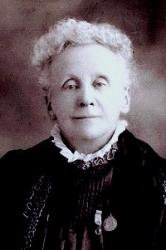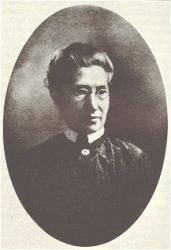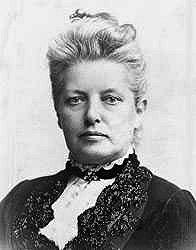Planning worship?
Check out our sister site, ZeteoSearch.org,
for 20+ additional resources related to your search.
- |
User Links
Person Results
Matilda Betham-Edwards

1836 - 1919 Person Name: Matilda B. Betham-Edwards, 1836-1919 Topics: Special Subjects and Occasions Childhood Author of "God Make My Life a Little Light" in Worship and Service Hymnal Born: March 4, 1836, Westerfield (near Ipswich), England.
Died: January 4, 1919, Hastings, Sussex, England.
[Matilda Betham Edwards (1836-1919)]
Daughter of Edward Edwards, and cousin of Egyptologist Amelia B. Edwards, Matilda was educated in Ipswich and Peckham, and traveled extensively, especially in Germany and France. Her works include:
The White House by the Sea, 1857
Dr. Jacob, 1864
Kitty, 1869
Poems, 1885
Lord of the Harvest, 1899
--www.hymntime.com/tch
==============================
Edwards, Matilda Barbara Betham (Betham-Edwards), daughter of Edward Edwards, and cousin of Amelia B. Edwards, the Egyptologist, was born at Westerfield, near Ipswich, March 4, 1836. Miss Edwards is well known as the author of Kitty, The Sylvesters, and other stories. Her Poems were published in 1885. Her hymn for Children's Services, "God make my life a little light," in the Congregational Church Hymnal, 1887, first appeared in Good Words, 1873, p. 393, together with another hymn for children, "The little birds now seek their rest" (Evening). Several of her religious pieces have passed into devotional and other works.
--John Julian, Dictionary of Hymnology, Appendix, Part II (1907)
Matilda Betham-Edwards
H. Breuchner
Person Name: H. Breuckner Topics: Childhood Translator of "There is a gentle Gard'ner " in Wartburg Hymnal
H. Breuchner
W. Davenant
Topics: Childhood Composer of "[I think when I read that sweet story of old]" in Gems of Song
W. Davenant
E. E. Hewitt

1851 - 1920 Topics: Childhood Author of "Very Little Tots" in Sunday School Hymns No. 1 Pseudonym: Lidie H. Edmunds.
Eliza Edmunds Hewitt was born in Philadelphia 28 June 1851. She was educated in the public schools and after graduation from high school became a teacher. However, she developed a spinal malady which cut short her career and made her a shut-in for many years. During her convalescence, she studied English literature. She felt a need to be useful to her church and began writing poems for the primary department. she went on to teach Sunday school, take an active part in the Philadelphia Elementary Union and become Superintendent of the primary department of Calvin Presbyterian Church.
Dianne Shapiro, from "The Singers and Their Songs: sketches of living gospel hymn writers" by Charles Hutchinson Gabriel (Chicago: The Rodeheaver Company, 1916)
E. E. Hewitt
Mary Mapes Dodge

1830 - 1905 Person Name: Mary M. Dodge, 1831-1905 Topics: Special Subjects and Occasions Childhood Author (attributed to) of "Can a Little Child Like Me?" in Worship and Service Hymnal Mary Mapes Dodge is the often referred to as the "leader in juvenile literature" (Clarke, 1059), for she helped create and perpetuate the most widely circulated and read children's magazine during a time when American printing technology greatly improved and enabled the mass production of magazines and books. Dodge was born on January 26, 1831 in New York City. She grew up in a prominent family with two sisters. Her "own reminiscences were of 'a devoted father and mother and a happy childhood, a remarkably happy childhood, watched over with loving care'" (Gannon 3). Beginning in her early childhood, Dodge and her sisters were educated by a tutor in their home. Their father introduced them to a large variety of literature from the Bible to Shakespeare because at that time Dodge's father believed that children's literature was "a dreary wasteland" (Gannon 4). Dodge's early exposure to literature enabled her to develop a gift and appreciation for art, music, and writing. In her teenage years, Dodge could skillfully write and she assisted her father with his writings for pamphlets.
In 1851 Mary celebrated her marriage to William Dodge, and within the next 4 years, she gave birth to two sons, James and Harrington. The Dodge family confronted several hardships throughout their life together. In 1857, William faced serious financial difficulties concerning debts and the destruction of the company he worked for. During that same year, at the age of six, their son James was diagnosed with a fatal sinus disease. The effect of these disastrous events caused William to leave his family in 1858. He left for a walk from which he never returned. A month after his disappearance his body was found dead from an apparent drowning.
After the death of her husband, Mary was left in a bad financial position and with two sons to raise on her own. At this time, Mary "resolved 'to take up her life again in the old spirit of rejoicing; to rear and educate her boys as their father would have done; to do a man's work with the persistent application and faithfulness of a man, to gain a man's pay, yet to leave herself freedom and freshness to enter into all her children's interests and pursuits as their comrade and friend" (Gannon 7). Mary would not allow the unfortunate events of her husband's death and financial difficulty stand in her way from educating her sons and providing them with the life they deserved. In addition to educating her sons, she began writing and editing in 1859. Mary worked with her father to publish two magazines, the Working Farmer and the United States Journal. The editorial work she used for these magazines helped to shape her writing skills, which she later applied to edit the most successful children's magazine of her time.
Some of Mary's early writings before the publication of St. Nicholas include The Irvington Stories (1864) and Hans Brinker (1865). Hans Brinker is by far Dodge's most well known story, for it was published in several languages all over the world and this classic was considered "the best and most faithful juvenile story" (Clarke 1063). Four years after the publication and success of Hans Brinker, Dodge began working for a newspaper known as Hearth and Home." Dodge worked on the juvenile and household departments under the editorship of Harriet Beecher Stowe. Roswell Smith, one of the founders of the children's magazine Scribner's Monthly, observed Dodge's work at Hearth and Home. Smith considered Dodge for the editor of his newly created children's magazine, St. Nicholas, named for the patron saint for children. Dodge faced a difficult decision because she wanted to pursue novel writing and other challenging fields, but her heart remained with children. "Many gifted men and women were writing novels; no one was doing all that could be done--ought to be done--for the boys and girls" (Clarke 1063), and thus Dodge accepted the position of editor for St. Nicholas.
Dodge's goal for her children's magazine was to create literature that inspired and interested children. In 1873 she anonymously wrote for Scribner's Monthly,"a successful children's magazine "must not be a milk-and-water variety of the periodical for adults. In fact, it needs to be stronger, truer, bolder, more uncompromising than the other; its cheer must be the cheer of the bird-song; it must mean freshness and heartiness, life and joy" (Clarke 1063). Mary clearly illustrates here her intention for the path St. Nicholas. Mary hoped to portray the traditional values of society, to educate children, to provide enjoyable entertainment, and to prepare them for "life as it is" (Kelly 380).
Dodge took careful consideration for the layout of her magazine so she could fulfill her goals for a successful children's magazine. Two important obstacles confronted Dodge when she considered the type of articles to include in her magazine. The first problem she faced was how to entice her readers and maintain their attention. Dodge's technique to overcome this problem was the use of "regular departments" and "reader involvement" (Gordon, 380). The most famous regular department found in her magazine was 'Jack-in-the-Pulpit'. 'Jack-in-the-Pulpit' was "the inimitably wise and witty little preacher whose tiny discourses of the keenest sense and most inspiriting nonsense, . . . were a feast for the mind and souls of young folks every month" (Clarke 1065). Jack was a maternal type character that reflected Dodge's own personality. Dodge hoped to instill value and morals into the children without directly preaching to them. Jack provided an advantageous resource for accomplishing this goal because he was witty, humorous, and sincere. The children reading the story could easily identify with Jack's "preachings" and accept them because they were not directly aimed at the reader. In addition, Dodge added two more characters, Deacon Green and Little Schoolma'am, to provide authority figures and the introduction of new and interesting knowledge for the readers.
The second technique Dodge employed for her periodical was reader involvement. Dodge included two features, "The Puzzle Box" and "The Letter-Box." "The Puzzle Box" provided entertainment for the readers through riddles or games. The answers to these games, however, were not included in the issue of the magazine. Readers had to send their answers to the publisher for judging, and only then could they find out the true answers. "The Letter-Box" included letters written to Dodge from the readers. Publication for readers was not only included in this section, but Dodge also encouraged children to contribute their own literature to the magazine.
St. Nicholas became one the most successful magazines for children during the second half of the nineteenth century. Circulation increased to almost 70,000 children all over the U.S. The success of this periodical can be attributed to Dodge's dedication and the many contributors. Dodge's persistence in finding extraordinary talents such as Louisa May Alcott, Rudyard Kipling, President Theodore Roosevelt, F. Scott Fitzgerald, and Sarah Orne Jewett provided a variety of intellectual and artistic material for children every month. St. Nicholas' began in 1873 and continued for the next 30 years with a few publications after Dodge's death in 1905. Dodges dedication to children is clearly evident in the hard work she devoted to this magazine. Dodge is an inspirational women who set goals people thought impossible, but ones she was able to achieve. In a memoir written after Dodge's death in a St. Nicholas publication, Dodge is described as a woman who put her heart into her work and achieved the goals she put forth. "What she attempted, she performed. There was no emergency, great or small, to which she was not equal; there was no Hill of Difficulty" (Clarke 1064). She was a woman to be truly admired, for her thirty years of work dedicated to children has influenced the world of periodicals ever since.
--www.facstaff.bucknell.edu/gcarr/ (excerpts)
Mary Mapes Dodge
John J. Daniell
1819 - 1898 Person Name: Rev. J. J. Daniell Topics: Childhood and Children's Service Author of "Come, Sing with Joy and Gladness" in Augsburg Songs No. 2 Daniell, John Jeremiah, born at Bath, Oct. 6, 1819. In 1848 he was ordained by the Bp. of Manchester. His subsequent charges included the curacies of Gerrans, Menheniot, Kington-Langley, and others, and the vicarages of Langley-Fitzurse, Winterborne-Stoke, and Berwick St. James, Wilts, and Langley-Burrell, having been preferred to the last in 1879. Mr. Daniell is the author of several prose works, as: Life of Mrs. Godolphin; The Geography of Cornwall, &c.; and of a poetical work, Lays of the English Cavaliers. His hymns in common use are:—
1. Alleluia, thanks and glory. Children praising Jesus. Contributed to the Society for Promoting Christian Knowledge Children's Hymns, No. 69.
2. Come, sing with holy gladness. Praise of Christ. Contributed to the Appendix of Hymns Ancient & Modern, 1868, and since adopted by several collections in Great Britain and America.
Mr. Daniell has also written several hymns for local use: but these have not appeared in the larger and more widely used collections. He died Nov. 1, 1898.
-- John Julian, Dictionary of Hymnology (1907)
John J. Daniell
John Page Hopps

1834 - 1911 Person Name: John Page Hopps (1834-1911) Topics: The young salvationist Childhood Author of "Father, lead me day by day" in The Song Book of the Salvation Army Hopps, John Page, was born in London, Nov. 6, 1834, and educated at the G. Baptist College, Leicester. Commencing public work in 1856, after a brief ministry at Hugglescote and Ibstock, in Leicestershire, he became colleague with George Dawson at the Church of the Saviour, Birmingham. From 1860 to 1876 he ministered to Unitarian congregations at Sheffield, Dukinfield, and Glasgow. Since 1876 he has preached in Leicester. Mr. Hopps has published many books and pamphlets, chiefly volumes of Sermons and Lectures. Most of his smaller works are controversial. In 1863 he commenced a monthly periodical called The Truthseeker. He has compiled the following hymnbooks for Congregational, Mission, or School purposes:—
(1) Hymns for Public Worship and the Home, 1858; (2) Hymns of Faith and Progress, c. 1865; (3) Hymns for Public Worship, 1873; (4) One hundred Hymns for Sunday Schools, 1873; (5) Hymns, Chants and Anthems for Public Worship, 1877; (6) The Children's Hymn Book, 1879; (7) The Young People's Book of Hymns, 1881; (8) and six different editions of Hymns for Special Services (for Sunday afternoon and evening gatherings in the Temperance Hall and Floral Hall, Leicester).
Mr. Hopps has himself written various hymns, some of considerable merit. Several have appeared in Congregational, Baptist, Unitarian and other collections. Among the best known are the following:—
1. Cold and cheerless, dark and drear. Winter.
2. Father, lead me day by day. Child's Prayer for Divine Guidance.
3. Father, let Thy kingdom come. God's Kingdom desired.
4. God bless the little children. Prayer for Children.
5. We praise Thee oft for hours of bliss. The blessings of Sorrow.
These hymns are from his Hymns, Chants, and Anthems, &c. 1877, and the Hymns for Special Services. The most popular is No. 2.
[Rev. W. R .Stevenson, M.A.]
--John Julian, Dictionary of Hymnology (1907)
John Page Hopps
Effie Chastain de Naylor
1889 - 1960 Topics: Childhood Translator of "Los niños y niñas de toda región" in El Himnario Born in Mexico in 1889 to parents from the U.S. who were missionaries. She married George Dent Naylor, a Methodist missionary and they worked in Guantánamo. She was a composer and choir director. Her music is widely used in Cuban churches.
Dianne Shapiro, from A Social History of Cuban's Protestants: God and the Nation, by James A.Baer (Lanham: Lexington Books, 2019)
Effie Chastain de Naylor
Sally Ann Morris
Topics: Children / Childhood Composer of "EZRA D" in Voices Together
Sally Ann Morris
Susan Palo Cherwien
1953 - 2021 Topics: Children / Childhood Author of "O Blessed Spring" in Voices Together
Susan Palo Cherwien


 My Starred Hymns
My Starred Hymns

